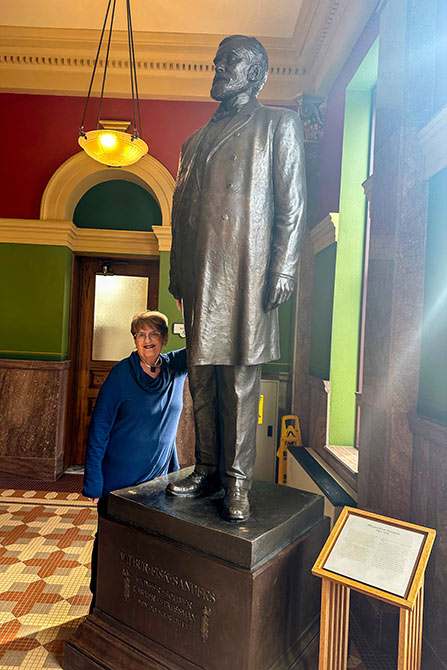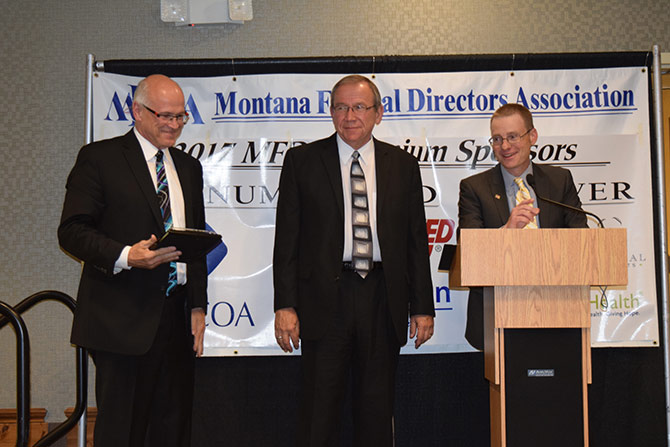Much of Montana’s “rich and rare” early history can be felt by passing through the large stone archway at the entrance to Forestvale Cemetery a few miles north of the Capitol at Helena, Montana.
More than 14,000 Montanans are buried at Forestvale, and more early Montana pioneers rest here than in any other place in Montana. It is listed on the National Registry of Historic Places. Montana gained statehood in 1889.
Information on the Forestvale entry sign states:
“You will find the graves of families that represent these pioneers who came to this territory after 1860 and developed this part of Montana as miners, businessmen, bankers, stockmen, politicians, and even gamblers. They came from all parts of the world. The monuments exemplify the social stratifications of early Helena from simple to elaborate.”
I found my way to Forestvale Cemetery via Los Angeles while researching my family tree. While in LA on business, I began an online search for the grave of my mother’s father, who had left the prairie of Montana for the silver screen. He was the son of an early prospector who dug gold out of Last Chance Gulch in what is now downtown Helena and invested in cattle and land, eventually developing a large ranch in eastern Montana. I was amazed to learn his grave was at Helena, and soon, I was there.
But that was just the beginning of a fascinating journey as I wandered from monument to monument. Perhaps I was most impressed by the large stone with the name of Wilbur Fiske Sanders, a politician key to Montana’s days as a territory and state. I walk past his “larger-than-life bronze statue” each day in the beautiful Capitol, where I am honored to serve Montana’s northwest corner as state senator.
Sanders, 1834-95, played a prominent role in the development of Montana Territory and served as U.S. senator from Jan. 1, 1890, to March 3, 1893. Earlier, Sanders served in the Montana Territorial House of Representatives from 1873-79. He was a skilled attorney who was the prosecuting attorney for the Vigilantes against the “Road Agents” in Virginia City. He had served as a first lieutenant in the Ohio Infantry at the Battle of Shiloh.
Others buried at Forestvale include vigilante leader and U.S. Marshall John X. Biedler. X, as he was frequently called, had been a shotgun messenger guard for Wells Fargo shipments on the long route from Helena to Corrine, Utah. Later, he served as U.S. marshal and Indian scout.
Another famed pioneer was a Methodist missionary affectionately referred to as “Brother Van,” William Van Orsdel, who preached in mining camp saloons and founded some 50 churches around Montana. His name is still remembered at Methodist churches and church conferences.
Even Helena’s once-thriving but segregated Chinese community is represented in the “China Row Section.” At least one story tells of gold being washed out of pockets and cuffs from miners’ clothing at the Chinese laundry.
Many more rest in peace at this beautiful plot on Prickly Pear Flats, including Sanders’ partner in life. See the headstone (feature image above):
His Faithful Wife,
Harriet Fenn Sanders
1884-1909
Should you visit Helena, reserve time to enjoy the bronze figures and busts of historical figures in the Capitol Building. See the beautiful twin steeples of St. Helena Catholic Cathedral, and stroll and shop the stores along the Last Chance Walking Mall in downtown Helena.
Remember old Irish Thomas Cruse, a hard-working prospector/miner/banker/rancher. He provided funds for both the Cathedral and the Capitol Building. He found and developed the Drumlummon Gold and Silver Mine. What an astonishing and tragic life he led.
These few words barely scratch the surface of the rich, rare and wild history and characters that created the modern-day community of Helena.
This article is courtesy of Montana Senior News with the author’s permission.











